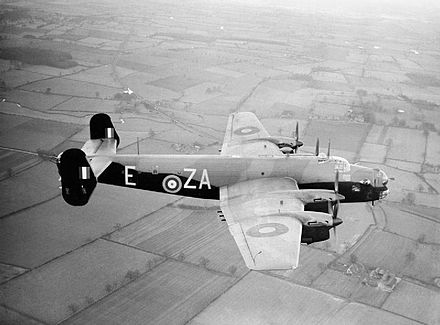 |
| The 10 Squadron Halifax Mark II, Series 1 at RAF Leeming, December 1941 - the plane flown by the two RAF crews shot down over Laval, June 10, 1944. |
The No. 10 has been repurposed throughout the last century from observation to bombing, transport and aerial refueling.
During World War II, the No. 10 was a bomber squadron. It lost two Halifax bombers to anti-aircraft fire over Laval, France on June 10, 1944, four days after D-Day.
One plane was piloted by F/O Henderson, an Australian, the other by a Dutchman who had been teaching at the University of Maryland and was flying for the Royal Canadian Air Force, F/O van Stockum (subject of the novel Time Bomber). The 14 crew members of the two planes have been memorialized by two monuments outside of Laval unveiled on June 10, 2014, on the 70th anniversary of their deaths.
These two planes were less than 2 percent of the 128 Halifax planes lost by the Squadron during the war's 300 missions. With seven airmen on each plane, that would be 896 flyers killed, or about three per mission. The loss of two planes, 14 crewmen, on one mission would be four times the average.
The 10th Squadron currently flies the Airbus Voyager, a transport and tanker.
First World War
1915-1919. No. 10 was formed in 1915, as part of the Royal Flying Corps, in 1915 at Farnborough Airfield, Hampshire, UK. It served as a spotter and bomber in France.
1928-1941. In 1928 it was reconstituted as a night bomber unit on Hyderabads at RAF Upper Heyford. It moved to RAF Boscombe Down in 1931 and later on to RAF Dishforth in 1937 to form part of the newly created No. 4 Group of RAF Bomber Command, using including Hinaidis, Vickers Virginias and Handley Page Heyfords.
Second World War 1941-1945
The squadron began in the Second World War as the first unit equipped with the Armstrong Whitworth Whitley.
The squadron remained a part of No. 4 Group throughout the war,re-equipping with the Halifax at the end of 1941.
In mid-July 1940 the squadron moved to RAF Leeming, Yorkshire. In mid-1942 they moved to RAF Melbourne, Yorkshire.
Since World War II
1945-50. No. 10 spent four years with Transport Command, flying Dakotas in India. After a one-year 1947-48 disbandment, No. 10 took over No. 238 Squadron and operated in Europe, taking part in the Berlin Airlift.
1953-1964. No. 10 Squadron reverted to its original bomber role, taking part in the Suez Crisis, equipped upon reformation at RAF Scampton with Martin B-57 Canberras, the first jet planes to drop bombs during combat. After 1968, the squadron was reformed at RAF Cottesmore, flying Handley Page Victors. The squadron's VC10s have also been used to fly the British Royal Family and top government ministers around the world. Former Prime Minister Tony Blair reverted to the VC10 for sensitive flights, such as during his diplomacy to Pakistan and after the 9/11 attacks.
 |
| No. 10's Vickers VC-10 C1 in 1977. |
2011-present. With the closure of RAF Lyneham and the transfer of the RAF's Hercules force to Brize Norton, No. 10 Squadron has been reformed as the first operator of the new Airbus Voyager.

No comments:
Post a Comment